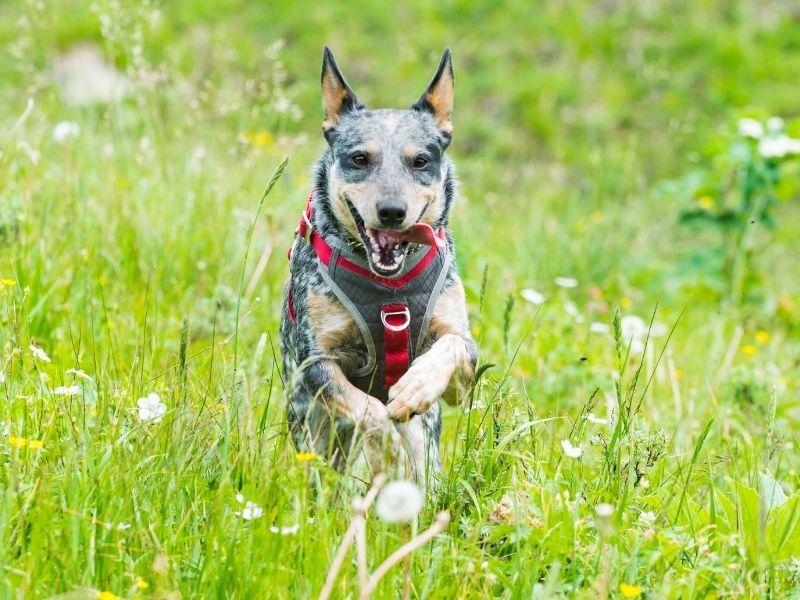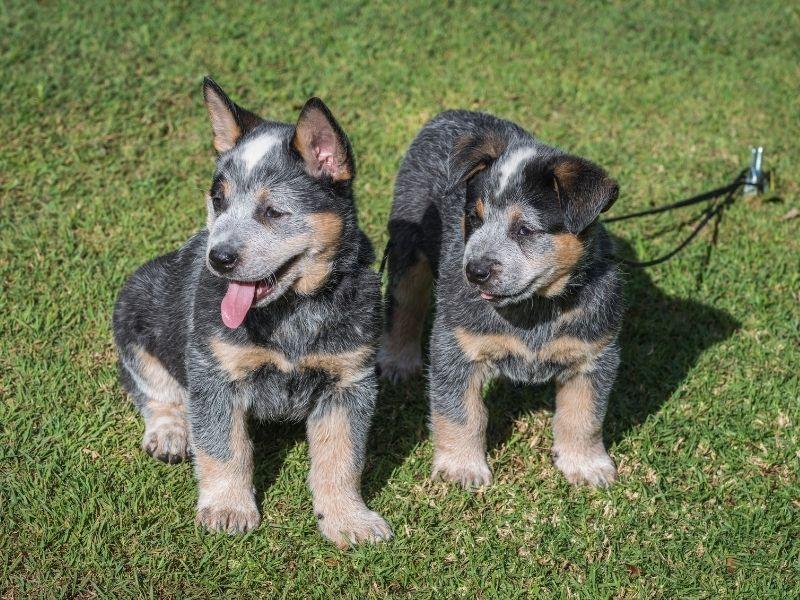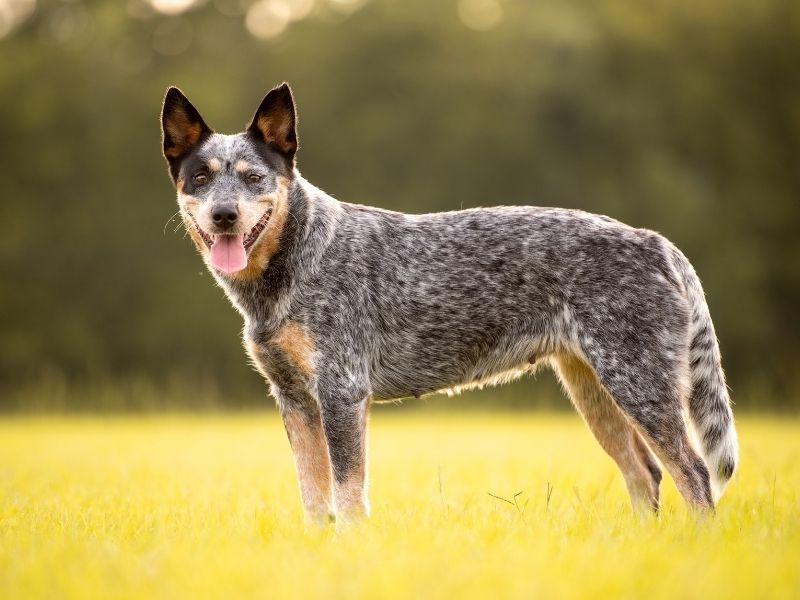The Blue Heeler, also known as the Australian Cattle Dog, is a medium-sized short-coated herding dog that originated in Australia. Their coats meld either brown or black, mixed evenly through white, which can give the appearance of a red or blue dog, hence either a ‘Red Heeler’ or a ‘Blue Heeler’. These dogs are compact and well-muscled with powerful jaws, extremely quick reflexes, and fast movement. They were originally bred to herd cattle on large ranches because of their size and versatility. The Heeler part of the name comes from their habit of nipping at the heels of cattle to encourage them to move. However, they are also excellent companion dogs and make great pets for active families. The Australian Blue Heeler (and Red Heeler) is a generational mix of two other breeds of dogs, the Northumbrian Collie from the UK, and the Dingo, the Australian Wild Dog. This breed is recognized by the American Kennel Club and classified as a herding dog.
What Is a Blue Heeler?
The Blue Heeler is a medium-sized herding dog that originated in Australia. Here are some of its distinctive features and characteristics:
i) Compact And Muscular Build
This dog has a compact and muscular build, with strong jaws and incredibly fast reflexes. It is also very agile, making it an excellent herding dog for large ranches. This makes it a highly versatile breed that is able to adapt well to different environments.
ii) Protective And Loyal Temperament
The Australian Blue Heeler is known for being loyal, protective, and intelligent. It forms very strong bonds with its human family members and will always remain by their side. It is also fiercely protective of its home and territory, so it is a good choice for families with young children or other pets.
iii) Requires Regular Exercise and Training
Although this breed is medium in size, it has lots of energy and requires regular exercise to stay fit and happy. It also needs ongoing training to ensure that its herding instincts are properly channeled and that it behaves well around other animals and people.
Overall, the Australian Blue Heeler is a wonderful breed that is perfect for active families or individuals who want a loyal companion dog. With the right care and training, it can be a great addition to any home.

What Are the Differences Between a Blue Heeler and a Mini Blue Heeler?
There are several key differences between a Blue Heeler and a Mini Blue Heeler:
i) Size and Build
A typical Blue Heeler is a medium-sized breed of dog, standing around 20 – 23 inches tall. In contrast, the Miniature Blue Heeler is much smaller in size, typically measuring only 15 – 19 inches tall. This makes it well suited for families with smaller children or homes with limited space.
ii) Temperament
While both breeds are known for being loyal, protective, and intelligent, the Miniature Blue Heeler is typically more reserved around strangers than its larger counterpart. It is also less likely to nip or herd people since it is smaller in size. As a result, it may be a better choice for families with young children or first-time dog owners.
iii) Exercise and training needs
Both the Blue Heeler and the Miniature Blue Heeler require regular exercise and training to stay happy and healthy. However, the Miniature Blue Heeler typically has less energy than its larger counterpart, so it may not need as much exercise. This breed also tends to be easier to train since it is more reserved around people and less likely to nip or herd.

See Also: Spotlight on The Small Munsterlander Dog Breed
And: A Look at Some Small Tibetan Dog Breeds
Are Blue Heelers Easy to Train?
The Blue Heeler is a highly intelligent breed, making it relatively easy to train. This dog is typically eager to please its owner and responds well to positive reinforcement techniques such as praise, treats, or playtime. However, this breed can also be stubborn at times, so it may require more consistent training and practice to ensure that it follows your commands. Here are some tips to help you train your Blue Heeler:
i) Start With Basic Obedience Commands
For any particular behavior, it is important to start with basic obedience commands such as sit, stay, come, down, or off. Once your dog has mastered these commands, you can begin to work on more specific behaviors.
ii) Use Positive Reinforcement Techniques
When training your dog, it is important to use positive reinforcement techniques such as praise, treats, or playtime. It will help your dog to associate good behavior with positive rewards, making it more likely to repeat the desired behavior.
iii) Be Consistent
One of the most important things to remember when training any dog is to be consistent with your commands and expectations. This means that everyone in your household should use the same commands and that you should maintain a regular training schedule to ensure that your dog is getting enough practice. With consistent training and positive reinforcement, your Australian Blue Heeler can quickly learn all of the behaviors necessary for a happy and well-behaved dog.
Is a Blue Heeler a Family Dog?
The Australian Blue Heeler can definitely be a family dog, as long as you are willing to put in the time and effort required to care for this energetic breed. This breed is loyal and protective of its human family, making it a great companion dog for active families with young children or other pets.
In addition, the Australian Blue Heeler is intelligent and easy to train, making it a great choice for first-time dog owners or families who are looking for a loyal companion. If you are interested in bringing an Australian Blue Heeler into your home, be sure to do your research ahead of time and work with a reputable breeder to ensure that you are getting a healthy and well-behaved dog. With proper care and training, the Australian Blue Heeler can make a great addition to any family!
Featured image: Australian Blue Heeler or Australian Cattle Dog

